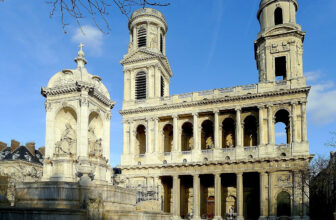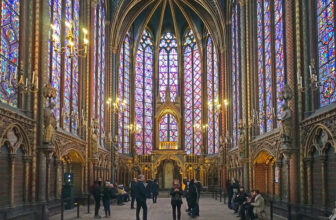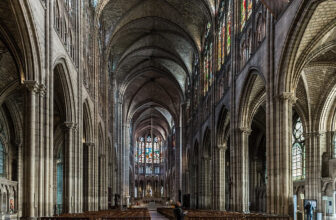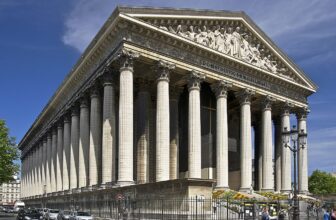
What to See Inside Saint-Paul-Saint-Louis?
Saint-Paul-Saint-Louis is one of the most beautiful and historically significant churches in Paris, located in the heart of the Marais district, one of the city’s oldest neighborhoods. The church is part of a grand historical context, and its beauty and cultural relevance make it an important landmark in the city. This post will explore why the church is famous, its historical and architectural significance, and what to see inside the church itself.
The Historical Significance of Saint-Paul-Saint-Louis
Saint-Paul-Saint-Louis, a stunning baroque-style church, was originally part of the Jesuit order’s mission to spread Catholicism in Paris. The church, which took nearly a century to complete, was inaugurated in 1641, although construction began several decades earlier. Its full name, Église Saint-Paul-Saint-Louis, comes from the dual names of Saint Paul the Apostle and Saint Louis, the King of France. The church is a reminder of the golden age of Paris during the 17th century, a period that saw immense cultural, religious, and architectural growth.
The Marais district itself is steeped in history. Once home to the nobility, it has transformed into a vibrant, diverse area filled with galleries, restaurants, and historical sites. The presence of the church in this neighborhood further enhances its appeal as a central point of Parisian heritage. Originally, the Jesuits built the church to serve as a spiritual center for both the local community and the many visitors who came to the area.
Architectural Significance
Saint-Paul-Saint-Louis stands as a prime example of baroque architecture in Paris, with a design that combines boldness, elegance, and dramatic effects. The architectural mastermind behind the church was the renowned French architect François d’Orbay, whose vision was to create a church that reflected the majesty and power of the Catholic Church during a time of growing political influence.
The building features a large central nave with intricate side chapels. The facade of the church is ornate, featuring sculpted columns, detailed reliefs, and a monumental entryway that commands attention. Above the entrance, you can find a series of statues depicting key religious figures, including Saint Paul and Saint Louis, both of whom are central to the church’s name and mission.
Saint-Paul-Saint-Louis is designed to be a “preachings church,” meaning it was specifically designed to accommodate large crowds of people who came to hear Jesuit sermons. As such, the interior is spacious and inviting, with a design that creates an atmosphere of solemnity and grandeur. The church’s construction utilized a mix of classical and baroque techniques, with a focus on lighting, space, and acoustics that would amplify the sound of the Jesuit preachers.
The high, vaulted ceilings and towering columns add to the feeling of expansiveness and grandeur, while the symmetrical design conveys order and reverence. The church’s overall structure and details are meant to inspire awe and remind visitors of the divine.
Why Saint-Paul-Saint-Louis is Famous
Saint-Paul-Saint-Louis stands out for several reasons that elevate it beyond just being another religious site in Paris. It has played a pivotal role in both the religious and cultural life of the city over centuries. Here are some of the main reasons why the church is famous:
1. Its Association with the Jesuit Order: The church’s creation is deeply tied to the Jesuit order, a Catholic religious group known for its educational, missionary, and theological work. The Jesuits, founded in the 16th century, established their presence in Paris and beyond, and Saint-Paul-Saint-Louis was a symbol of their strength and influence in the city. The Jesuits were key figures in the Counter-Reformation, and the church was meant to be a powerful tool for preaching their message.
2. Cultural and Artistic Importance: Saint-Paul-Saint-Louis also became a cultural hub during the 17th and 18th centuries. Many famous artists, musicians, and thinkers were associated with the church, either through the Jesuit teachings or simply because of the church’s reputation as a center of intellectual and artistic life. It was at Saint-Paul-Saint-Louis that many influential figures, including philosophers, writers, and composers, gathered for sermons and intellectual discussions.
3. Its Historical Context: The Marais district was once the heart of aristocratic Parisian life. Saint-Paul-Saint-Louis, constructed during a period of religious and political turbulence in France, became a focal point for both the aristocracy and common people. Its rich history as part of the development of the district gives it an additional layer of fame.
4. The Role in the French Revolution: During the French Revolution, many religious buildings were targeted, but Saint-Paul-Saint-Louis survived, though it underwent some changes. It became a secular temple, a common fate for many churches during that turbulent period. Afterward, the church returned to its religious function and resumed its important role in Parisian religious life.
5. The Restoration and Preservation of the Church: While the church underwent periods of neglect and damage, especially after the revolution, it has been continuously restored and maintained. Today, it stands as a well-preserved example of 17th-century architecture, attracting both tourists and Parisians who admire its beauty and historical significance.
What to See Inside Saint-Paul-Saint-Louis
When you step inside the church, you are greeted with a stunning interior that captures the grandeur and spirit of its construction. The interior features several noteworthy elements, each contributing to the overall sense of sacred beauty and architectural sophistication.
1. The High Altar: The high altar of Saint-Paul-Saint-Louis is one of its most impressive features. It stands at the heart of the church and is adorned with golden details that radiate warmth and divine light. The altar is dedicated to Saint Louis, the patron saint of France, and Saint Paul, the apostle. It serves as the focal point for religious ceremonies and provides a sense of connection to the divine.
2. The Vaulted Ceilings: The vaulted ceilings are one of the most awe-inspiring aspects of the interior. Painted in rich colors and adorned with delicate religious motifs, the ceilings create a sense of height and openness. The intricate designs highlight the magnificence of the architecture and draw visitors’ eyes upward, encouraging a sense of reverence and awe.
3. The Stained Glass Windows: The church boasts a series of beautiful stained glass windows that flood the interior with light. These windows depict scenes from the lives of saints and biblical events, with each one offering a unique story in vivid color. The use of stained glass was particularly important in the baroque era, as it served both an artistic and spiritual purpose, bringing the divine closer to the everyday world.
4. The Side Chapels: Saint-Paul-Saint-Louis features several side chapels, each dedicated to different saints and religious figures. These chapels, with their smaller altars and statues, provide intimate spaces for prayer and reflection. They also feature impressive art, sculptures, and relics that tell the stories of various saints.
5. The Organ: One of the most important features of Saint-Paul-Saint-Louis is its organ. The church is renowned for its exceptional acoustics, making it a favored location for concerts and performances. The organ itself is a masterpiece of design and craftsmanship, often used for both religious ceremonies and musical performances. Its sound fills the church, creating a dramatic and moving atmosphere during mass and special events.
6. The Art and Sculptures: Throughout the church, visitors will find beautiful works of art, including sculptures and paintings. These pieces illustrate various aspects of Catholicism and the lives of saints, adding depth and beauty to the church’s atmosphere. The mix of baroque sculptures and classical paintings gives the interior a rich, multi-layered aesthetic.
7. The Crypt: Though not always accessible to the public, the crypt of Saint-Paul-Saint-Louis is a fascinating part of the church. It is home to several tombs, including those of important figures in the church’s history. The crypt is a quiet, solemn place that provides a sense of connection to the past.
8. The Baptismal Font: Located near the entrance, the baptismal font at Saint-Paul-Saint-Louis is a notable feature. Used for baptisms, the font is a symbol of the church’s role in welcoming new members into the Christian faith. The design of the font is both simple and elegant, adding to the overall harmonious feeling of the church.
Saint-Paul-Saint-Louis stands as a testament to the history and culture of Paris. From its architectural grandeur to its rich religious and cultural significance, the church has left an indelible mark on the city’s history. Whether you are admiring its baroque-style design, exploring its artistic treasures, or reflecting on its historical significance, Saint-Paul-Saint-Louis offers a unique and enriching experience for all who visit.





